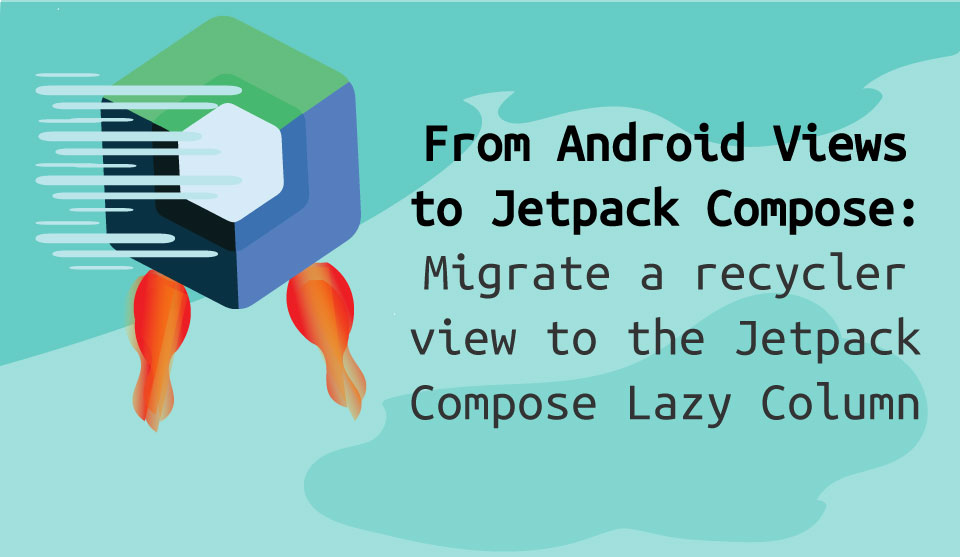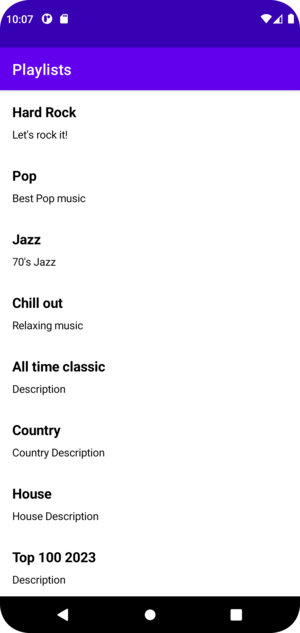
Jetpack Compose and why it matters
Jetpack Compose is a revolutionary UI toolkit introduced by Google for building native Android applications. Unlike traditional Android Views, Jetpack Compose adopts a declarative approach to UI development, allowing developers to create user interfaces using composable functions.
This paradigm shift simplifies UI development by eliminating the need for complex view hierarchies and manual view updates. With Jetpack Compose, developers can express the desired UI state and let the framework handle the rendering and updating automatically. This results in cleaner and more readable code, improved productivity, and faster UI development cycles.
Jetpack Compose offers a modern and intuitive way to build UIs, enabling developers to create beautiful, responsive, and highly interactive Android applications with ease. Its importance lies in providing a more efficient and enjoyable development experience, enabling developers to focus on crafting exceptional user experiences while reducing boilerplate code and increasing code maintainability.
And the cherry on top? No more Android Fragments! We all had our fair share of pain trying to comprehend and debug the complex Fragment lifecycle. With Jetpack Compose, we can put an end to it! That’s right, Composables can take the Fragments’ place as reusable UI components that are tied up to an Activity.
Declarative UI building is the way that all front-facing applications are moving towards. It was first introduced by React in 2013. After its successful adoption in the web, it later moved to cross platform mobile platforms such as React Native and Flutter. Realizing its advantages, both native platforms, Android and iOS, have recently made a similar move by introducing Jetpack Compose and SwiftUI. Soon all other UI-creating tools will be a thing of the past.
Understanding RecyclerView and its Limitations
RecyclerView has long been a popular component in Android app development for efficiently displaying lists and grids. It offers flexibility and performance optimizations by recycling views as users scroll through the list, reducing memory consumption and improving scrolling smoothness. However, RecyclerView also comes with its limitations. Managing view recycling, implementing complex adapter logic, and supporting different view types for diverse list items can often lead to boilerplate code and increased development effort.
Additionally, RecyclerView lacks built-in support for animations and complex layout transitions, making it challenging to create dynamic and visually engaging user interfaces. These limitations have prompted developers to seek alternative solutions that offer a more streamlined and intuitive approach to building user interfaces. The Jetpack Compose Column and Lazy Column are coming to the rescue.
Analyzing the Existing RecyclerView Implementation
We are creating an application that fetches a list of playlists and displays them on the screen. The initial implementation is based on Android Fragment and Recycler View. Let's take a closer look at the code structure and components involved:
class PlaylistFragment : Fragment() {
private val viewModel: PlaylistViewModel by viewModels()
@Injected
var playlistAdapter: PlaylistAdapter
override fun onCreateView(
inflater: LayoutInflater,
container: ViewGroup?,
savedInstanceState: Bundle?
): View {
// Inflate the layout for this fragment
val view = inflater.inflate(R.layout.fragment_playlist, container, false)
val playlistsRecyclerView: RecyclerView = view.findViewById(R.id.recyclerView)
playlistsRecyclerView.layoutManager = LinearLayoutManager(requireContext())
playlistsRecyclerView.adapter = playlistAdapter
lifecycleScope.launchWhenStarted {
viewModel.playlists.collect { playlists ->
playlistAdapter.submitList(playlists)
}
}
return view
}
}
Our Fragment depends on the ViewModel, which exposes a Kotlin StateFlow that emits a list of playlists. We observe this StateFlow using the collect method, and upon receiving the updated list, we populate the RecyclerView with the playlist items by calling submitList. The RecyclerView is set up with a custom adapter that extends the RecyclerView Adapter and holds a list of playlists as its data source.
Below is the respective code for the RecyclerView Adapter:
class PlaylistAdapter : RecyclerView.Adapter<PlaylistAdapter.PlaylistViewHolder>() {
private var playlistItems: List<Playlist> = emptyList()
override fun onCreateViewHolder(parent: ViewGroup, viewType: Int): PlaylistViewHolder {
val itemView = LayoutInflater.from(parent.context)
.inflate(R.layout.item_playlist, parent, false)
return PlaylistViewHolder(itemView)
}
override fun onBindViewHolder(holder: PlaylistViewHolder, position: Int) {
val playlist = playlistItems[position]
holder.bind(playlist)
}
override fun getItemCount(): Int {
return playlistItems.size
}
inner class PlaylistViewHolder(itemView: View) : RecyclerView.ViewHolder(itemView) {
private val titleTextView: TextView = itemView.findViewById(R.id.titleTextView)
private val descriptionTextView: TextView = itemView.findViewById(R.id.descriptionTextView)
fun bind(playlist: Playlist) {
titleTextView.text = playlist.title
descriptionTextView.text = playlist.description
}
}
fun submitList(playlists: List<Playlist>) {
playlistItems = playlists
notifyDataSetChanged()
}
}
Within the adapter, we override the necessary methods, such as onCreateViewHolder, onBindViewHolder, and getItemCount to handle view creation, data binding, and determining the item count respectively. The item layout XML file defines the visual representation of each playlist item, containing the necessary views and bindings.
As we explained earlier, RecyclerView implementations require a lot of boilerplate and repetitive code.
Jetpack Compose Column vs Lazy Column
Before we jump into improving our implementation with Jetpack Compose, let’s discuss the differences between the Column and LazyColumn components.
In Jetpack Compose, both Column and LazyColumn are composable functions used to display vertical lists of UI elements. The primary difference lies in their behavior and performance optimization. The Column is suitable for a small number of items or when the entire list can fit on the screen. It lays out all its children regardless of whether they are currently visible on the screen, which may lead to performance issues with large lists. For short lists, rendering the items from the start offers increased performance.
On the other hand, LazyColumn is optimized for handling large lists efficiently. It loads only the visible items on the screen and recycles the off-screen items, similar to the traditional RecyclerView. This approach reduces memory consumption and enhances scrolling performance for long lists. Therefore, LazyColumn is the preferred choice when dealing with extensive datasets or dynamic content, ensuring a smooth and responsive user experience.
Setting Up Jetpack Compose in the Project
In order to use Jetpack Compose in our project, we need to complete the following setup steps:
Step 1: Add the Jetpack Compose dependency in build.gradle
plugins {
id 'com.android.application'
id 'kotlin-android'
}
android {
// ...
buildFeatures {
compose true // Enable Jetpack Compose
}
composeOptions {
kotlinCompilerExtensionVersion = “$version”
}
// ...
}
dependencies {
implementation "androidx.compose.ui:ui:$compose_version" // Check for the latest version
implementation "androidx.compose.material:material:$material_version" // Check for the latest version
implementation "androidx.activity:activity-compose:$compose_version" // Check for the latest version
// ...
}
Step 2: Initialize Jetpack Compose In your Application class, in the onCreate method.
class MyApplication : Application() {
override fun onCreate() {
super.onCreate()
AppCompatDelegate.setDefaultNightMode(AppCompatDelegate.MODE_NIGHT_NO) // Optional: Disable dark mode
}
}
You can now start adding Composables inside your MainActivity and leverage the power of Jetpack Compose!
class MainActivity : AppCompatActivity() {
override fun onCreate(savedInstanceState: Bundle?) {
super.onCreate(savedInstanceState)
setContent {
//TODO add a composable
}
}
}
Migrating RecyclerView to Lazy Column
Jetpack Compose belongs to the declarative UI family. In declarative UI, we receive the state of the data that needs to be displayed, and we programmatically create the views. The views are immutable, and their state cannot change. Every time the data state changes, everything is being redrawn on the screen, and the views recreated from scratch. Practically, behind the scenes, there are smart diffing mechanisms that don’t redraw elements that their data hasn’t changed. But we, as developers, must write code as if everything is being redrawn when the data changes.
Let’s see how we can refactor the playlists screen with Jetpack Compose.
As we promised earlier, with Jetpack Compose, we can get rid of the Android Fragments. Everything is Jetpack Compose, from a whole screen to a small UI element, is a composable. The composables are functions instead on objects. This reflects one of the paradigm shifts that the declarative UI introduces. We are moving towards stateless functional programming instead of stafeful object oriented programming.
Let’s start by replacing our PlaylistFragment with a screen composable.
@Composable
fun PlaylistScreen(viewModel: PlaylistViewModel) {
val playlists by viewModel.playlists.collectAsState()
LazyColumn {
items(playlists) { playlist ->
PlaylistItem(playlist = playlist)
}
}
}
The PlaylistScreen composable represents the screen where the playlists are displayed. It collects the playlists from the PlaylistViewModel using collectAsState to recompose the composable whenever the playlist data changes automatically. The main component in the PlaylistScreen is the LazyColumn, which is a Jetpack Compose equivalent of RecyclerView. It handles view recycling and renders only the visible items on the screen. Every time the playlist StateFlow emits another result, the composable function PlaylistScreen will automatically recompose, and the UI be redrawn with the updated data.
Each list item is described by the composable below:
@Composable
fun PlaylistItem(playlist: Playlist) {
// Custom composable for rendering an individual playlist item
Column(
modifier = Modifier
.fillMaxWidth()
.padding(16.dp)
) {
Text(
text = playlist.title,
style = TextStyle(fontWeight = FontWeight.Bold, fontSize = 18.sp)
)
Spacer(modifier = Modifier.height(8.dp))
Text(text = playlist.description)
}
}
The PlaylistItem composable represents an individual playlist item. We use a Column composable to stack the title and description texts vertically. We apply styling and padding.
With Jetpack Compose's LazyColumn, we achieve a more concise and declarative way of displaying the list of playlists without the need for a separate adapter or view holder logic. The composable functions automatically handle the UI rendering and updates based on the provided state. This refactoring results in cleaner, moer reuseable and more maintainable code, making UI development more intuitive and efficient. Furthermore, we don’t have to handle the Fragment’s complex lifecycle while retaining the benefit of reusable UI components.

Figure: The playlist with Compose's LazyColumn
Handling Clicks
Handling clicks in the Jetpack Compose Column component is super easy, we simply need to add the ‘clickable’ modifier and call the code that we want to execute when the respective list item is clicked. We have access to selected playlist model info.
@Composable
fun PlaylistItem(playlist: Playlist) {
// Custom composable for rendering an individual playlist item
Column(
modifier = Modifier
.fillMaxWidth()
.clickable { /* Handle item click here */ }
.padding(16.dp)
) {
Text(
text = playlist.title,
style = TextStyle(fontWeight = FontWeight.Bold, fontSize = 18.sp)
)
Spacer(modifier = Modifier.height(8.dp))
Text(text = playlist.description)
}
}
Testing
As good engineers, we should always include automated tests that verify that our code works correctly. With Jetpack Compose, UI testing is much easier than before. Let’s see how we can test the PlaylistScreen after we migrate it to Jetpack Compose.
@ExperimentalCoroutinesApi
@get:Rule
val composeTestRule = createComposeRule()
@OptIn(ExperimentalCoroutinesApi::class)
@Test
fun playlistScreen_RenderList_Success() {
// Dummy data for testing
val playlists = listOf(
Playlist("Playlist 1", "Description 1"),
Playlist("Playlist 2", "Description 2"),
Playlist("Playlist 3", "Description 3")
)
// Create a TestCoroutineDispatcher to be used with Dispatchers.Main
val testDispatcher = TestCoroutineDispatcher()
val testCoroutineScope = TestCoroutineScope(testDispatcher)
// Launch the composable with TestCoroutineScope
testCoroutineScope.launch {
composeTestRule.setContent {
PlaylistScreen(viewModel = PlaylistViewModel(playlists))
}
}
// Wait for recomposition
composeTestRule.waitForIdle()
// Check if each playlist item is rendered correctly
playlists.forEach { playlist ->
composeTestRule.onNode(hasText(playlist.title)).assertIsDisplayed()
composeTestRule.onNode(hasText(playlist.description)).assertIsDisplayed()
}
}
In this test, we use the createComposeRule to set up the Compose test rule. We also create a TestCoroutineDispatcher and a TestCoroutineScope to simulate the background coroutine execution. Then, we launch the PlaylistScreen composable with dummy data for testing. After the recomposition, we use onNode to check if each playlist item title and description is correctly displayed. Note that we are testing UI, therefore this is an instrumentation test that must be inserted under the AndroidTest folder.
Let’s now see how we can test the PlaylistItem in isolation:
@get:Rule
val composeTestRule = createComposeRule()
@Test
fun playlistItem_Render_Success() {
val playlist = Playlist("Playlist 1", "Description 1")
composeTestRule.setContent {
PlaylistItem(playlist = playlist)
}
composeTestRule.onNode(hasText(playlist.title)).assertIsDisplayed()
composeTestRule.onNode(hasText(playlist.description)).assertIsDisplayed()
}
In this test, we use the createComposeRule to set up the Compose test rule. We then render the PlaylistItem composable with a dummy Playlist object. After rendering, we use onNode to check if the playlist title and description are correctly displayed.
These automated tests use Jetpack Compose's testing libraries to verify if the PlaylistScreen and PlaylistItem composables render as expected. They help ensure that the UI is correctly displayed and the appropriate data is rendered, providing confidence in the correctness of your composable functions. Remember to import the necessary dependencies and adapt the test code to your specific project setup.
Conclusion
Declarative UI is the future both in the web and mobile platforms. All major players have already adopted it, and it looks like all the other UI generation tools will eventually become deprecated.
It introduces a paradigm shift in building the UI where the views are immutable, and their state cannot change. When the data state changes, the views are recreated from scratch and are put to display the data updates.
Declarative UI building and Jetpack Compose specifically offer advantages such as simpler code that is easier to read, write and maintain. As a bonus, we can get rid of Fragments while maintaining the advantage of reusable UI components.
Shipbook offers fantastic Jetpack Compose debugging capabilities. You can add logs to monitor any UI rendering errors. Those will enable you to track, trace and fix every issue efficiently and effectively.
The sooner you start getting your hands on it, the better!
